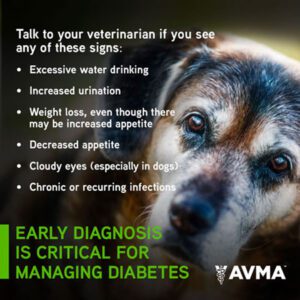Approximately 1 in 200 cats and 1 in 300 dogs have diabetes. But, cats and dogs with the disease can lead long, happy lives with proper management. For Pet Diabetes Awareness Month, here at The COVE, we’d like to educate pet owners on how to recognize the signs of diabetes and how it’s treated.
What Is Diabetes in Dogs and Cats?
Just like in humans, diabetes occurs when your pet’s body doesn’t make enough insulin, stops producing it entirely, or doesn’t utilize it properly—which then affects the concentration of glucose (sugar) in your pet’s blood. If there’s not enough insulin, glucose can’t enter cells and will build up to elevated concentrations in the bloodstream. As a result, pets with diabetes may eat frequently, but appear malnourished because their cells can’t absorb glucose. And as the pet eats more, glucose concentrations get higher in the blood. It’s a vicious cycle.
Symptoms of Diabetes
- Excessive thirst
- Excessive urination (produces more urine/day or has accidents in the house)
- Excessive hunger while losing weight
- Less active
- Cloudy eyes
- Dry, thinning, and dull fur
Treatment
Although there is no cure for diabetes, it’s definitely manageable. Treatment is all about controlling blood sugar. Daily insulin injections are usually required to control your pet’s blood sugar. Many pet parents worry about giving injections, but it’s easier than you think—and it’s worth it for your pet’s health, quality of life, and longevity.
In addition to insulin, the other parts of the treatment equation include diet, exercise, and weight management. Diet plays a vital role in helping keep your pet’s diabetes regulated. High-protein, low-carbohydrate foods are recommended because they provide the energy dogs and cats require, without the carbs that can turn into excess blood sugar. Exercise is essential for pets with diabetes, but it needs to be regimented because activity affects blood sugar levels—so create a consistent exercise routine. Proper diet and exercise will help manage your pet’s weight, which in turn helps with insulin and diabetes control.

If your pet is diagnosed with diabetes, your primary care veterinarian will show you how to check your dog or cat’s blood sugar, teach you how to give insulin injections, and will recommend a personalized diet plan.
It may seem a lot to take in at first, but you can do it! With early detection and proper treatment, a pet with diabetes should have the same life expectancy as a pet without diabetes. That is why early diagnosis and treatment are so important.
The COVE Open 24/7 for Emergencies
If your pet is having a diabetic emergency, you can trust in the care of our emergency department led by a board-certified specialist in emergency and critical care. The COVE is open 24 hours a day, 365 days a year.
About Us
The COVE’s veterinarians and staff wholeheartedly embrace the core values of community, collaboration, commitment, compassion, and integrity. This focus ensures that pets, the people who love them, and their primary care veterinarians have as positive and affirming a healthcare experience as possible, regardless of the circumstances that bring us all together.
